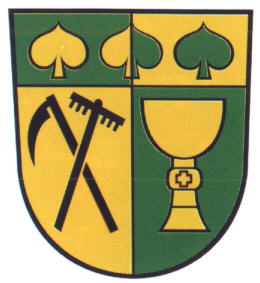Hardisleben: Difference between revisions
Knorrepoes (talk | contribs) m (Text replacement - ". ===Origin/meaning===" to ". |- |'''English''' | {{blazon wanted}} |} ===Origin/meaning=== ") |
Knorrepoes (talk | contribs) m (Text replacement - "===Origin/meaning=== The" to "===Origin/meaning=== The") |
||
| Line 21: | Line 21: | ||
===Origin/meaning=== | ===Origin/meaning=== | ||
The arms were officially granted on September 5, 1997. | The arms were officially granted on September 5, 1997. | ||
Revision as of 07:58, 18 July 2022
This page is part of the German heraldry portal Deutsche Wappensammlung |
Heraldry of the World |
|
German heraldry:
|
Selected collector's items from Germany:
|
HARDISLEBEN
State : Thüringen
District (Kreis) : Sömmerda
Incorporated into : 2019 Buttstädt
| German |
Gespalten von Gold und Grün mit einem von Grün und Gold gespaltenen Schildhaupt, darin drei Lindenblätter in verwechselten Tinkturen; vom eine schwarze Sense und ein schwarzer Rechen gekreuzt; hinten ein goldener Kelch. |
| English | No blazon/translation known. Please click here to send your (heraldic !) blazon or translation |
Origin/meaning
The arms were officially granted on September 5, 1997.
The chief shows three linden leaves, taken from the old seal of the village, which showed a linden tree. The tools are a symbol for the agricultural character of the village. The chalice is the symbol of St. John Baptist, the local patron saint.
The colours are those of Sachsen-Weimar-Eisenach, to which the village belonged until 1918.
Contact and Support
Partners:
Your logo here ?
Contact us
© since 1995, Heraldry of the World, Ralf Hartemink 
Index of the site
Literature : Ulle, 2011












